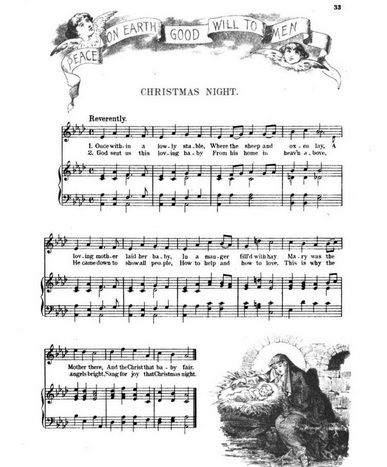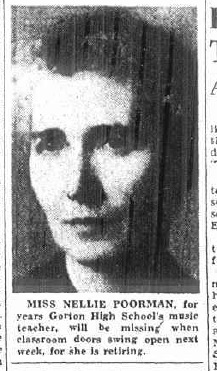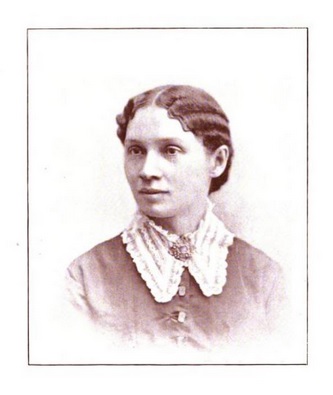Once Within a Lowly Stable / God Is Watching Over All / God Is Love / Little Lambs So White and Fair / Jesus Bids Us Shine
Obviously, this is not a comprehensive list of all the songs about Heavenly Father or Jesus in The Children’s Songbook. In each of these songs, either authorship is credited incorrectly, or there are missing dates for author or composer.
Once Within a Lowly Stable
Text: Patty S. Hill, 1893
Music: Mildred J. Hill, 1893
“Once Within a Lowly Stable” was first published in Song Stories for the Kindergarten (1893), a collection of songs for children by sisters Patty and Mildred Hill. The Children’s Songbook credits the authorship thus: “Words and music: Patty Smith Hill, 1868–1946, and Mildred Hill.” However, the title page of Song Stories for the Kindergarten clearly states: “Music composed and arranged by Mildred J. Hill; Words written and adapted by Patty S. Hill.” Their song was originally titled “Christmas Night.” [1]

The words of this song were first published by the Church in the Juvenile Instructor, December 15, 1902. [2] The complete song with music was published in Little Stories in Song (1940). [3]
Mildred Jane Hill (1859-1916), a songwriter and musicologist, was the oldest of the six children of the Rev. William Wallace and Martha Smith Hill. Patty Smith Hall (1868-1946) was professor emeritus of education Columbia at University and a pioneer in early-childhood education. The two sisters are remembered today for their collaboration on the song “Good Morning to All,” also published in Song Stories for the Kindergarten (1893), which later became the song “Happy Birthday to You.”
God Is Watching Over All
Text: Nellie Poorman, 1934
Music: Franz Schubert, 1813; adapt. ca. 1905; alt. 1936
The words of “God’s Is Watching Over All” were first published under the title “God’s Care” in a collection of short stories edited by B. R. Buckingham, titled Munching Peter and Other Stories (1934). [4] This collection contained 31 short stories, followed by 10 short poems. “God’s Care” was one of these poems. The first stanza reads:
God has numbered in the sky
All the stars that shine on high;
Worlds so great and sparrows small,
God is watching over all.

Munching Peter and Other Stories (1934)
Two years later these words were paired with a melody adapted from Franz Schubert and published in Tuning Up (1936), one of the books in the World of Music series. [5] The title was changed to “Loving Care.”

Nellie Poorman (1884-1965), author of the words, was the daughter of James H. Poorman and Caroline Fuller, and was born on April 24, 1884 in Clinton, Iowa. She was attended Northwestern University and received a Bachelor of Music degree from the American Conservatory of Music in Chicago. After graduation she worked as supervisor of music in the Evanston public schools. She taught school in Clinton, Iowa, and in Dewitt, Iowa for several years, and in 1914 got a job at Northwestern University as instructor in Public School Music Methods. Afterward she taught music in the upstate New York public schools in the town of Chazy. In 1924, she accepted a job as a music teacher in Yonkers, New York. She taught music at Gorton High School in Yonkers until 1943, when she was forced to retire because of a physical disability. She died on June 4, 1965 in Cedar Rapids, Iowa. Nellie Poorman is only known to have published one book of music, Songman’s Pack: Laden with Pretty Wares from Many Lands (Chicago, 1914), a collection of folk songs. [6]
The melody of this song was probably adapted from Franz Schubert’s Kyrie in B Flat Major, composed in 1813. The first two measures are almost identical. [7]

It was first adapted by Frances Weld Danielson and Grace Wilbur Conant as “Snow Song” in Songs for Little People (1905). [8]

This tune was later slightly altered to fit the words of “Loving Care” in Tuning Up (1936), one of the books in the World of Music series.
“Loving Care” was first published by the Church in The Children Sing (1951). [9]. The Children’s Songbook (1989) changed the title to the last line of the first stanza, “God is Watching Over All.”
God’s Love
Text: Elizabeth Cushing Taylor, ca. 1930
Music: Grace Wilbur Conant, 1930
- We do not see the wind;
We only hear it sigh.
It makes the grasses bend
Whenever it goes by. - We do not see God’s love,
But in our hearts we know
He watches over us
Wherever we may go. - We do not have to see
To know the wind is here;
We do not have to see
To know God’s love is near.
These words, by Elizabeth Cushing Taylor (1885-1972), are reminiscent of Christina Rossetti’s “Who Has Seen the Wind?”:
Who has seen the wind
Neither I nor you:
But when the leaves hang trembling,
The wind is passing through.
Who has seen the wind?
Neither you nor I:
But when the trees bow down their heads,
The wind is passing by. [10]
Primary Music and Worship (1930) is the first songbook to publish “God’s Love.” A notice at the bottom of the page indicates that the music, by Grace Wilbur Conant, is copyrighted 1930 by the Presbyterian Board of Christian Education (the publisher of this collection), but that the words are “copyright by Picture Story Paper. Used by Permission.” [11] Picture Story Paper was a children’s magazine published by the Methodist Book Concern. Only a few libraries have copies of this periodical, so the original publication of the text has not yet been found.
The Children’s Songbook gives no dates for Elizabeth Cushing Taylor, but her identity is no longer a mystery. [12] She was born on May 29, 1885 in Altamonte Springs, Florida, the daughter of Carlos Dyer Cushing (1853-1943) and Ella Richardson Cushing (1855-1938). When she was a young girl, Cushing’s family moved to Massachusetts. She was a graduate of the Boston Girls’ High School and the Framingham Normal School. She graduated in 1906, and afterward taught school in the towns of Westford, Chelmsford, and Lincoln. She married William Reuben Taylor on December 23, 1913, in Framingham, Massachusetts. They made their home in Westford, Massachusetts, where they lived for the next forty-seven years. Her husband passed away in 1960. There are no records that indicate they had any children. Elizabeth Cushing Taylor died on February 27, 1972, in Lowell, Massachusetts. [13]
Little Lambs So White and Fair
Text: Elizabeth Whitney Brown, 1859
Music: B. L. W., 1887

The words of this short song were first published in the Advocate and Family Garden (New York), June 1, 1859, signed “E. W. Brown.” [14]
The text is printed anonymously in The Children’s Songbook, but the author’s full name is Elizabeth Whitney Brown (1838-1904). The poem appears under the title “Little Lambs” in her posthumous collection Poems and Letters (1907). [15] The original poem consists of three stanzas of eight lines each, but The Children’s Songbook uses only a small portion of this poem. It prints only the first eight lines, divided up into two different stanzas.

The music, also anonymous in The Children’s Songbook, was first published in Gertrude Walker and Harriet S. Jenks’ Songs and Games for Little Ones (1887), attributed to “B. L. W.” [16]

There is no information available concerning B. L. W.
This song was first published by the Church in the Deseret Sunday School Union Kindergarten Plan Book (1904). [17] It was reprinted in the Juvenile Instructor twice: in April 15, 1905 and April 1922. [18] However, it was not added to the primary songbook until 1940, when it was printed in Little Stories in Song. [19] It has been reprinted in every subsequent primary songbook to the present [2023].
Jesus Bids Us Shine
Text: either Susan Bogert Warner or Anna Bartlett Warner, 1862
Music: Adam C. Smyth, 1901
“Jesus Bids Us Shine” is not in the current children’s songbook. It was last published by the Church in the 1948 edition of The Primary Songbook. It is included here because it is a lovely little song that fits well with the other songs above. It commences:
Jesus bids us shine with a clear pure light,
Like a little candle burning in the night;
In this world of darkness we must shine –
You in your small corner, and I in mine.
The words are somewhat reminiscent of the spiritual “This Little Light of Mine.” Both take their message from Matthew 5:14-16:
“14 Ye are the light of the world. A city that is set on a hill cannot be hid.
15 Neither do men light a candle, and put it under a bushel, but on a candlestick; and it giveth light unto all that are in the house.
16 Let your light so shine before men, that they may see your good works, and glorify your Father which is in heaven.”
There has been confusion over the authorship of the text of this hymn. It has been credited variously to Susan Bogert Warner, Anna Bartlett Warner, and Emily Huntington Miller.
In Appendix II of John Julian’s Dictionary of Hymnology, “Jesus Bids Us Shine” was included on a list of hymns written by Emily Huntington Miller. [20] However, James Mearns later added a correction in the New Supplement, stating that numbers 7, 8, and 9 on this list were not the work of Miller: “No. 8, ‘Jesus Bids Us Shine,’ she informs us is by Susan Warner.” [21]
Wikipedia claims the words of this song were first published in the children’s magazine the Little Corporal in 1868. [22] However, this is incorrect. The poem was published earlier in the Little American, a semi-monthly children’s newspaper published at West Point, New York, and edited by sisters Susan Bogert Warner and Anna Bartlett Warner. The poem appears in the first issue of this newspaper, on October 1, 1862, under the title “Little Lights.” [23]
No author was credited. Further confusing the matter, “Little Lights” appears in the 1863 printing of The Children of Blackberry Hollow, a collection of six short stories. The book was published anonymously, but advertisements in the Caledonian Mercury (Edinburgh, Scotland) indicate that its author was Anna Warner. [24] It is possible she wrote this poem, rather than Susan, but unfortunately, neither of them made further mention of it in their writings. In any case, one of the Warner sisters likely wrote this text.
The tune found in The Primary Songbook is by Latter-day Saint composer Adam Craik Smyth and was first published in the Juvenile Instructor, October 15, 1901. [25] It was reprinted in first edition of The Primary Songbook in 1905. [26]
Notes:
[1] Mildred J. Hill and Patty S. Hill, Song Stories for the Kindergarten (Chicago: Clayton F. Summy Co..1893), 23. The 1893 edition is not online. The above link is for the 1896 enlarged edition.
[2] “Christmas Night,” Juvenile Instructor 37, no. 24 (December 15, 1902), 764-765
[3] Little Stories in Song (Salt Lake City: Deseret Book Company, 1940), 23
[4] B. R. Buckingham, Munching Peter and Other Stories, (Boston: Ginn and Company, 1934), 296
[5] Mabelle Glenn, Helen S. Leavitt, Victor L. F. Rebmann, and Earl L. Baker, The World of Music: Tuning Up (Boston: Ginn and Company, 1936), 119
[Note: the book available to view at Archive.org is the 1943 enlarged edition.]
[6] Biographical sources for Nellie Poorman:
* “United States Census, 1900,” database with images, FamilySearch (https://www.familysearch.org/ark:/61903/1:1:M9KW-H5P : Sun Sep 17 14:35:28 UTC 2023), Entry for James Poorman and Caroline Poorman, 1900.
* Clinton, Iowa, City Directory, 1901, “U.S., City Directories, 1822-1995 for Nellie A Poorman,” Ancestry.com
* “Dewitt,” Daily Times (Davenport, Iowa), August 23. 1912, 7
* “Catalog,” Northwestern University, 1914
* “Dewitt,” Davenport Democrat and Leader, June 14, 1915, 4
* “Notes and News,” The Dial 62, no. 743 (May 31, 1917):490
* “United States Census, 1920,” database with images, FamilySearch (https://www.familysearch.org/ark:/61903/1:1:MJ2Q-WK5 : Thu Aug 31 13:16:57 UTC 2023), Entry for Nellie Poorman, 1920.
* “G. H. S. Students Preparing for Commencement,” Yonkers Statesman, June 11, 1925, 4
* “3 Gorton High Teachers Ill,” Yonkers Statesman, February 2, 1928, 3
* “United States Census, 1940,” database with images, FamilySearch (https://www.familysearch.org/ark:/61903/1:1:K31R-5QL : Thu Sep 28 18:54:00 UTC 2023), Entry for Mary C Sabin and Nellie Poorman, 1940.
* “Miss Poorman, Teacher, Retires,” Herald Statesman (Yonkers, New York), August 9, 1943, 5
* “Familiar Faces to be Missing Among Faculty,” Herald Statesman (Yonkers, New York), August 31, 1943, n. p.
* “United States, Social Security Numerical Identification Files (NUMIDENT), 1936-2007,” database, FamilySearch (https://www.familysearch.org/ark:/61903/1:1:6K7B-S9JL : 10 February 2023), Nellie Poorman,
* “Nellie Poorman” in the “Iowa, U.S., Death Records, 1880-1972,” Ancestry.com, database with image, accessed September 29, 2023
* Nellie Poorman, Songman’s Pack (1914).
[7] Franz Schubert, Kyrie in B flat Major (1813) [note: Schubert’s older brother Ferdinand Schubert later plagiarized this tune in his Pastorale-Messe (1833). [see Soprano Solo, Kyrie]
[8] Frances Weld Danielson and Grace Wilbur Conant, Songs for Little People: for use in the Sunday-school the Kindergarten and the Home (New York: Eaton & Mains, 1905), 106
[9] The Children Sing (Salt Lake City: Church of Jesus Christ of Latter-day Saints, 1951), no. 34
[10] Christina G. Rossetti, Sing-Song: A Nursery-Rhyme Book (London, George Routledge and Sons, 1872), 93
[11] Primary Music and Worship (Philadelphia: Presbyterian Board of Christian Eductation, 1930), no. 24. Interestingly, this book is also the first to publish the words to another song in The Children’s Songbook, “Stars Were Gleaming.”
[12] Several sources published during Elizabeth Cushing Taylor’s lifetime indicate she was a resident of Westford, Massachusetts. See Catalog of Copyright Entries, Part 3: Musical Compositions, New Series, Volume 22 For the Year 1927 (Washington, D. C.: United States Government Printing Office, 1928), 862.
* See also Anita Browne, Homespun: An Anthology of Poetry by the General Federation of Women’s Clubs (New York: American Book Company, 1936), 445
* “Personals,” Lasell Leaves 54, no. 1 (November 1928): 27
[13] Biographical sources for Elizabeth Cushing Taylor:
* “United States Census, 1900,” database with images, FamilySearch (https://www.familysearch.org/ark:/61903/1:1:M9YB-NRJ : Sun Sep 17 09:42:58 UTC 2023), Entry for Carlos Cushing and Ella M Cushing, 1900.
* “Taylor-Cushing,” Boston Globe, December 24, 1913, 6
* “Find A Grave Index,” database, FamilySearch (https://www.familysearch.org/ark:/61903/1:1:W6J3-T86Z : 10 September 2021), William Reuben Taylor, ; Burial, Westford, Middlesex, Massachusetts, United States of America, Fairview Cemetery; citing record ID 199750947, Find a Grave, http://www.findagrave.com.
* “Elizabeth C. Taylor,” Lowell Sun, February 28, 1972, p. 20
[14] “Little lambs so white and fair,” Advocate and Family Garden , New York 25, no. 11 (June 1, 1859), 174
[15] Elizabeth Whitney Brown, Poems and Letters (Cincinnati: The Ebbert & Richardson Co., 1907), 27. Elizabeth Whitney Brown (also known as Eliza Whitney Brown) was born on September 30, 1838, in Sudiya, Assam, India. The daughter of missionaries Eliza Whitney Ballard Brown and the Rev. Nathan Brown, Elizabeth lived in India until she was seven years old. After three of their five children died because of climate-related illnesses, Mrs. Brown brought the two surviving children, Elizabeth and William, to the United States to live with family in East Charlemont, Massachusetts, while she returned to her missionary work and husband in India. In 1855, the family reunited when the Rev. and Mrs. Brown came back to America. They made their home in Hudson City (later named Jersey City), New Jersey. Elizabeth became a teacher and taught school in Brooklyn and New York City. Eventually, she had to give up teaching because of ill health. She then devoted her time to writing. Elizabeth’s mother died in 1871, and her father afterward moved to Yokohama, Japan. Elizabeth lived with her father for many years in Yokohama, and after his death she penned his biography, published in 1890. By 1900, she was living in Manhattan with her friend Elizabeth Ann Rogers. She died in East Charlemont, Massachusetts, on August 30, 1904.
Biographical Sources:
- E. W. Brown, The Whole World Kin: A Pioneer Experience Among Remote Tribes, and Other Labors of Nathan Brown (Philadelphia: Hubbard Brothers, 1890)
- “Obituary: Elizabeth Whitney Brown,” Gazette and Courier (Greenfield, Massachusetts), September 24, 1904, 7
- “Miss Elizabeth Whitney Brown,” Holyoke Daily Transcript (Holyoke, Mass) , September 2, 1904, 7
- “A memorial to Elizabeth W. Brown,” New York Times, November 25, 1905, 811
[16] Gertrude Walker and Harriet S. Jenks, Songs and Games for Little Ones (1887), 9
[17] Donnette Smith Kesler and Rebecca Morris, Deseret Sunday School Union Kindergarten Plan Book (Salt Lake City: Deseret Sunday School Union, 1904), 44
[18] “Little Lambs so White and Fair,” Juvenile Instructor 40, no. 8 (April 15, 1905), 235
[19] Little Stories in Song (Salt Lake City: Deseret Book Company, 1940), p. 30
[20] John Julian, A Dictionary of Hymnology, Rev. ed. with New Supplement (London: John Murray, 1908), 1579-1580
[21] John Julian, A Dictionary of Hymnology, Rev. ed. with New Supplement (London: John Murray, 1908), 1672
[22] “Jesus Bids Us Shine,” Wikipedia, last updated December 28, 2022
[23] “Little Lights,” Little American 1, no. 1 (October 1, 1862), 8. The top of the page says “Edited by the author of the ‘Wide, Wide World,’ and the author of ‘Dollars and Cents.’” Wide, Wide World was written by Susan Warner, and Dollars and Cents was written by Anna Bartlett Warner. The last paragraph of the last page says: “All other communication address to Miss Warner, West Point, N. Y”
[24] See “James Nisbet & Co.’s New Publications,” Caledonian Mercury (Edinburgh, Scotland), November 21, 1863, 5. This same advertisement appears in this newspaper on November 28, December 5, 12, and 26, 1863.
[25] “Jesus Bids Us Shine,” Juvenile Instructor, October 15, 1901. [25]
[26] The Primary Song Book (Salt Lake City: General Board of Primary Associations, 1905), no. 12